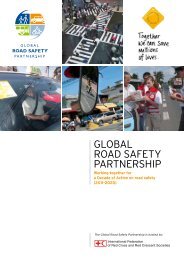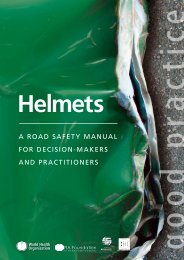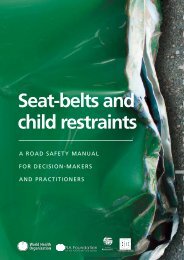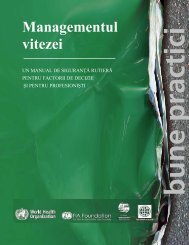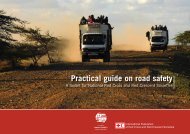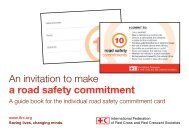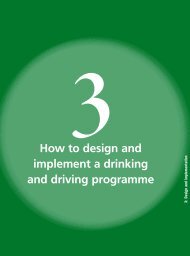Proactive Partnership Strategy - Global Road Safety Partnership
Proactive Partnership Strategy - Global Road Safety Partnership
Proactive Partnership Strategy - Global Road Safety Partnership
Create successful ePaper yourself
Turn your PDF publications into a flip-book with our unique Google optimized e-Paper software.
Step 3. Integrated <strong>Road</strong><br />
<strong>Safety</strong> Actions<br />
(PPP - <strong>Proactive</strong> <strong>Partnership</strong> Process)<br />
It is assumed that the community already has some kind of <strong>Road</strong> <strong>Safety</strong><br />
<strong>Strategy</strong> in place. This is one of the conditions of GRSP being part of the PPS<br />
Team.<br />
A <strong>Road</strong> <strong>Safety</strong> Action Plan or <strong>Strategy</strong> provides a strategic direction for road<br />
safety in a defined jurisdiction and describes the outcomes to be achieved<br />
within a set time frame. It sets out how it will significantly reduce deaths and<br />
injuries on the roads and usually includes:<br />
• the approach to road safety using initiatives built around the Safe Systems<br />
of <strong>Road</strong>s, Vehicles, People and Trauma Care Services and using the four<br />
Es (engineering, education, enforcement and emergency services)<br />
to achieve a goal of an affordable, integrated, safe, responsive and<br />
sustainable transport system<br />
• the priority areas that will be a focus of the immediate investment in road<br />
safety<br />
• the stages of identified initiatives - what is the time frame of the initiative<br />
and what are the tasks in each period<br />
• the co-ordination, funding and other mechanisms that will be involved in<br />
implementing the strategy.<br />
In developing the Action Plan or <strong>Strategy</strong> the team needs to take into<br />
consideration the World Report on <strong>Road</strong> Traffic Injury Prevention and use it as<br />
a framework for road safety efforts. This guides the implemention of actions<br />
that will address the main risk factors related to crashes, fatalities and serious<br />
injuries. The needs of vulnerable road users and building the capacity road<br />
safety management should also be a priority within the Plan.<br />
Activity<br />
Examine the community’s <strong>Road</strong><br />
<strong>Safety</strong> <strong>Strategy</strong>. Identify how the<br />
set Targets (refer back to Step 2)<br />
complement or overlook the<br />
strategies or priorities listed. If there<br />
are differences how can this be<br />
managed<br />
To focus or extend the PPS Team<br />
further discussions could centre on<br />
the following questions:<br />
• Which body is responsible<br />
for the legal standards in the<br />
community (In relation to, for<br />
example, signage, speed zones,<br />
helmet standards, Breath Alcohol<br />
Content limits etc.)<br />
• What standards are optional<br />
Why might they be optional<br />
• Who regulates or enforces the<br />
legal standards / regulations in<br />
the community<br />
• Where do people learn about<br />
the legal standards and<br />
requirements<br />
• What new inventions, standards<br />
or laws related to the safety<br />
of the road users needs to be<br />
introduced<br />
Note:<br />
It is quite possible that the existing strategy in a PPS Community was written in the<br />
absence of reliable 30 day data and reviewing or updating it may be a very early<br />
task of the PPS Team.<br />
41<br />
<strong>Proactive</strong> <strong>Partnership</strong> <strong>Strategy</strong>





